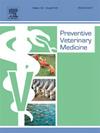Modelling spillover risk of highly pathogenic avian influenza from wild birds to poultry in Denmark
IF 2.4
2区 农林科学
Q1 VETERINARY SCIENCES
引用次数: 0
Abstract
Spillover risks of contagious diseases affecting both wildlife and farm animals are of growing concern. Since late 2020, several waves of highly pathogenic avian influenza virus (HPAIV) clade 2.3.4.4b have been observed in poultry farms in Denmark, impacting the poultry industry. Concurrently, many wild birds have been found infected and dead of this disease. As the epidemic developed, 49 farm outbreaks and over 2000 infected wild birds were detected in Denmark from late 2020–2024. Thus, it is important to investigate the interactions between wild birds and poultry farms and identify the spillover risks of HPAIV from free-living wild birds to domestic poultry. Using a previously developed mechanistic model for HPAIV in Danish wild birds and statistical tests (including correlation tests and logistic regressions), we quantified this spillover risk in Denmark in space and time. The mechanistic model identified a constant hot spot of HPAIV spillover risk in southern Zealand which corresponds to the hot spot previously identified using reported poultry outbreaks. The model estimated farm-specific risks with a precision level of 78 % for the simulated period. The population changes of the barnacle goose (Branta leucopsis) were found to be significantly associated with poultry outbreaks. A 3-week time lag across Denmark between wild bird HPAIV detections and subsequent poultry outbreaks was discovered, together with regional differences of this time lag. Our study showed the relationships between wild bird populations/detections and poultry outbreaks and the simulated weekly risk maps can help decision-making for prevention and surveillance.
模拟丹麦高致病性禽流感从野生鸟类向家禽的溢出风险
影响野生动物和农场动物的传染病的溢出风险日益令人关切。自2020年底以来,在丹麦的家禽养殖场观察到几波高致病性禽流感病毒(HPAIV)进化枝2.3.4.4b,影响了家禽业。同时,发现许多野生鸟类感染并死于这种疾病。随着疫情的发展,从2020年底至2024年,丹麦发现了49起农场疫情和2000多只受感染的野生鸟类。因此,调查野生鸟类与家禽养殖场之间的相互作用,并确定HPAIV从自由生活的野生鸟类到家禽的溢出风险是重要的。使用先前开发的丹麦野生鸟类HPAIV机制模型和统计测试(包括相关测试和逻辑回归),我们在空间和时间上量化了丹麦的这种溢出风险。该机制模型确定了新西兰南部HPAIV外溢风险的恒定热点,该热点与先前利用报告的家禽暴发确定的热点相对应。该模型在模拟期间估计农场特有风险的精度水平为78% %。发现藤壶鹅(Branta leucopsis)的种群变化与家禽暴发有显著相关。在丹麦发现野鸟HPAIV病毒和随后的家禽疫情之间存在3周的时间差,以及这一时间差的区域差异。我们的研究表明,野生鸟类种群/检测与家禽暴发之间的关系以及模拟的每周风险图可以帮助制定预防和监测决策。
本文章由计算机程序翻译,如有差异,请以英文原文为准。
求助全文
约1分钟内获得全文
求助全文
来源期刊

Preventive veterinary medicine
农林科学-兽医学
CiteScore
5.60
自引率
7.70%
发文量
184
审稿时长
3 months
期刊介绍:
Preventive Veterinary Medicine is one of the leading international resources for scientific reports on animal health programs and preventive veterinary medicine. The journal follows the guidelines for standardizing and strengthening the reporting of biomedical research which are available from the CONSORT, MOOSE, PRISMA, REFLECT, STARD, and STROBE statements. The journal focuses on:
Epidemiology of health events relevant to domestic and wild animals;
Economic impacts of epidemic and endemic animal and zoonotic diseases;
Latest methods and approaches in veterinary epidemiology;
Disease and infection control or eradication measures;
The "One Health" concept and the relationships between veterinary medicine, human health, animal-production systems, and the environment;
Development of new techniques in surveillance systems and diagnosis;
Evaluation and control of diseases in animal populations.
 求助内容:
求助内容: 应助结果提醒方式:
应助结果提醒方式:


